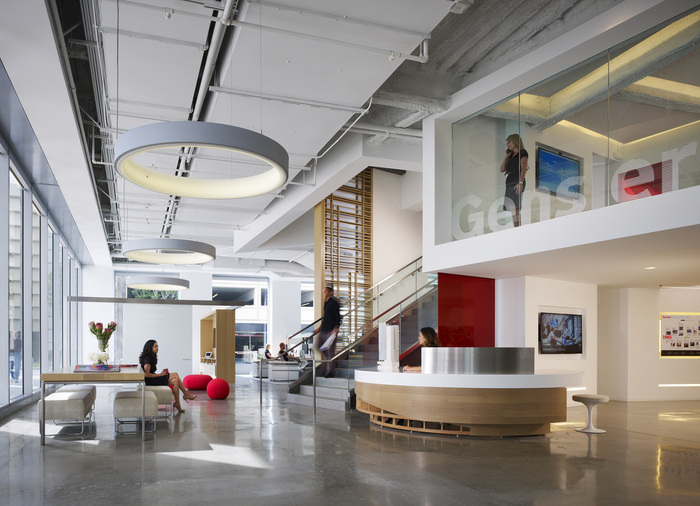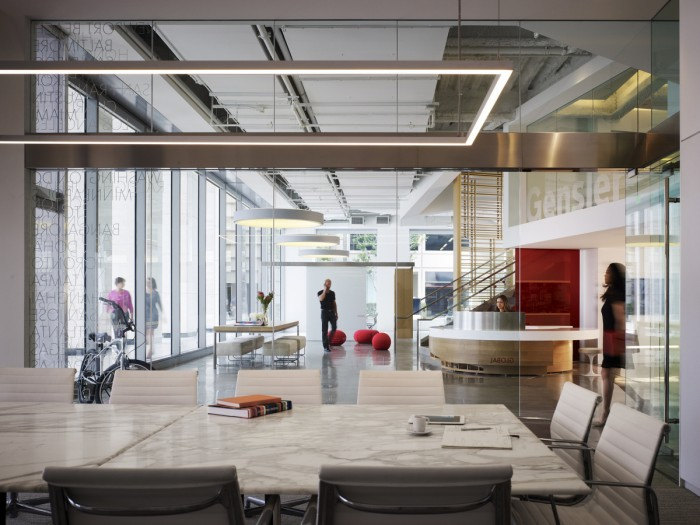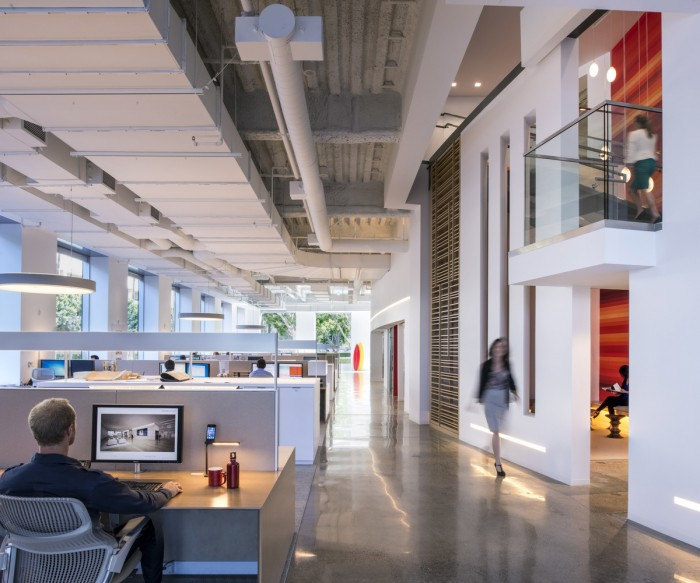
On Collaboration: An Interview with Gensler Principal Kim Graham
On Collaboration is an editorial series of interviews investigating the concept of collaboration in the modern workplace.
In the 8 years since Office Snapshots began publishing, we’ve watched the idea of the collaborative office rise to the level of an almost meaningless buzzword. But collaboration – working together to achieve a goal or complete a task – is an essential ingredient in any workplace that will not disappear any time soon.
—
We recently spoke with Kim Graham, Regional Managing Principal, Southwest Region, from global architecture and design firm Gensler. She tells us about what collaboration in the contemporary office landscape looks like and how the firm works to help clients create an environment which matches the unique needs of each organization.
Image above from Gensler’s Newport Beach offices – Nick Merrick, Hedrich Blessing Photography.
—
Office Snapshots: What does a collaborative office space look for a client of Gensler? Is it different depending on the company?
Kim Graham: A collaborative office space will vary depending on a company’s organization needs. As designers, recognizing what our clients value most allows us to create higher-performing work environments that are more effective for individuals, teams and entire organizations.
For over 50 years, we have been designing workplaces for organizations ranging from Fortune 100 global leaders to start-ups and fast growing tech companies. The central theme of our work is enhancing the human experience and helping people optimize their performance at work.
Gensler’s Newport Beach Offices
Photography: Nick Merrick, Hedrich Blessing PhotographyOS: Do companies ask you for a “collaborative office” or do those needs present themselves through discussions about what their needs are?
KG: Many clients want to enhance collaborative work within their organization. As part of defining a workplace design strategy, we engage with our clients to better understand their needs for all of the work modes. This discovery process informs our approach to create a variety of work settings that will accelerate work performance.
As designers who are also researchers, we believe in using data, evidence and analysis to fuel creative solutions to these core questions. Gensler’s U.S. Workplace Survey 2016 is the latest in a series that builds on over a decade of workplace research. We started our journey in 2005 by uncovering a link between a better designed work environment and performance. In every subsequent survey, we have tried to peel back the layers of comprehension—to understand why, and how, workplace makes an impact. Through the years, we have uncovered how people work, and we’ve found that effective workplace design links to higher business performance.
Our 2016 Workplace Survey focused on understanding the relationship between workplace design and innovation. We asked the question “how can the workplace be a catalyst for innovation in today’s organization?” Great workplace design drives creativity and innovation. Our research has found that every organization can optimize their workplace to improve performance and drive innovation, by integrating three key areas of the innovation ecosystem:
- Invest in the Individual – Employees at innovative companies have better designed and more functional workspaces, no matter how open – and if those functional aspects are managed, an open office can be just as effective as a private one.
- Diversify Group Work Spaces – Top-performing employees have access to, and use, a greater variety of workspaces in and out of the office, particularly for non-focus activities. They are also less likely to report having to work in the same space, and much less likely to socialize at their desks.
- Empower the Whole Community – Expand choice and autonomy across the whole organization – the ability to work when and where is best for the task at hand can have a positive impact at every level.
OS: We often see companies thinking of collaboration as being “putting employees in an open plan and watch them collaborate”. Do you find that there are misconceptions about what collaborative work environments are?
KG: The common challenge facing companies and organizations who want to redesign their workspaces is finding ways to balance focus with collaboration. Unfortunately, a full two thirds of U.S. workplaces have not kept pace with the needs of an innovative workforce. To address this gap in the modern workplace, it’s important to recognize and avoid the common misconceptions and myths surrounding how people work and what they need in today’s workplace.
Many people believe collaboration is the primary goal of an innovative workplace, however, our workplace research has found that’s actually a myth. The reality is that all four work modes are essential: focus, collaboration, learning and socializing. In fact, over the past 8 years, our research has shown that individual focus work has consistently remained around 45 percent of time spent in the office, and focus work continues to be the most critical of the four work modes.
It’s a common perception that today’s work environment is all about collaboration. In reality, while virtual collaboration has doubled over the last few years, increasing from 7% in 2013 to 15% in 2016, most of this collaboration is occurring at the desk, and not in designated collaboration zones, which can be distracting to others. Innovators desire a variety of both open and enclosed work settings to perform at their best.
Gensler’s Newport Beach Offices
Photography: Ryan GobutyOS: Is the actual act of collaborating something that is design-driven or culture-driven? Or both?
KG: The act of collaborating is culture-driven, but it can be executed successfully through great design. Over the past 100 years, how we work has changed dramatically, and these changes have impacted workplace design. The workplace in the early part of the 20th century was characterized by productivity, and workplace design focused on efficiency. By the 1980s, the personal computer revolutionized how we work and launched the knowledge economy. Workplace design captured the spirit of individualization with the adoption of office landscapes and cubicles of every shape and size.
Today’s workplace is characterized by the drive toward innovation. While productivity and leveraging knowledge are still critical, innovation is now a stated and unstated tenant of business strategy—and workplace design is changing to focus on achieving innovation and collaboration.
OS: Do you have any other thoughts about what a collaborative office environment is or isn’t or should be?
KG: While collaboration is important to all industries, time spent in collaboration varies great across industries. The aggregate findings from Gensler’s 2016 Workplace Survey show that companies that prioritize both individual and group work outperform all others. Innovation is possible in every space type – both open and enclosed, assigned and unassigned.
The open office versus private office decision is often debated, however our research shows that if designed to address key drivers of what makes the biggest difference to innovators, the best open plan offices can be as effective as a private one.




























